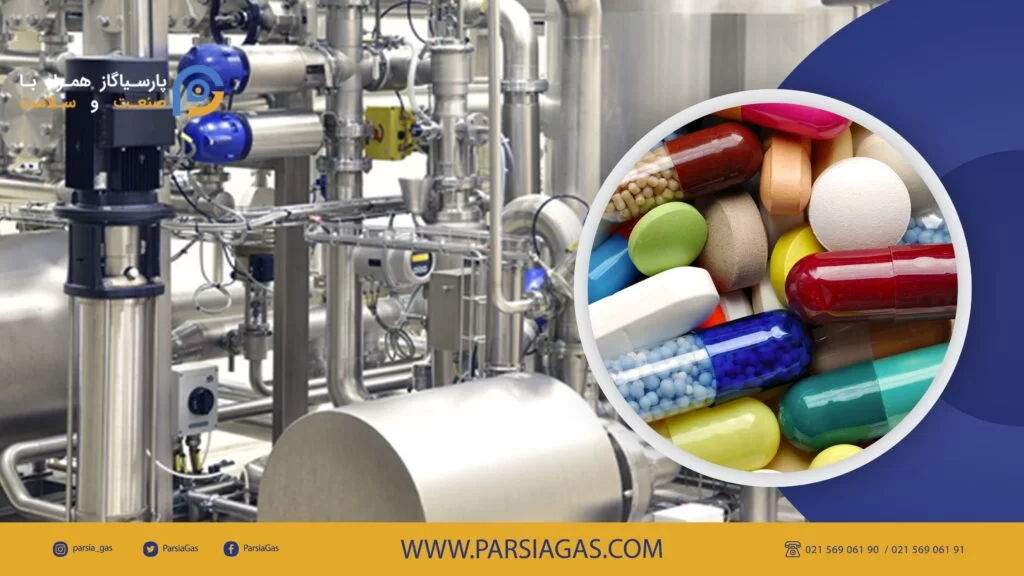The use of gases in the pharmaceutical industry
Pharmaceuticals and biotechnology is another industry that Parsia Gas provides the gases they need to maintain and develop their daily operations.
Our gases help you achieve process reproducibility, drug discovery, process development, product quality, cost savings and making the world a healthier place. Nitrogen gas is generally used in purging, pressure transfer, consolidation, and coating (protecting a process from moisture intrusion), oxidation, degradation, and contamination.
What are medicinal gases?
Medicinal and medical gases are liquids produced specifically for the medical, pharmaceutical and biotechnology industries. They are often used to synthesize, sterilize, or isolate processes or products that contribute to human health.

Gases used in the field of human health care are strictly controlled by both laws and industry standards so as not to harm human physiology. Gases of this type, produced as pure gases or as compounds, are always filtered to the highest possible quality. The application of each individual gas determines its production and distribution
Medical grade gases are used in the following cases:
- In the field of pharmaceutical and medical products production. They may be used in the synthesis of these items to test the packaging of these items or to insulate them from adverse environmental effects such as oxidation.
- As an analytical agent, for calibrating medical devices or diagnosing disease by gas culture or biopsy and examining patient response.
- As a treatment, in which the gas is prescribed as an anesthetic agent, drug delivery agent, or medication for potential ailments.
- As a space in environments where the composition of the air should be regulated.
- As a pneumatic power source for surgical and dental instruments.
Gases that are commonly used in the pharmaceutical industry are:
- Nitrogen to neutralize or flush
- Air for washing
- Oxygen for fermentation
- Carbon dioxide for extraction and purification
Nitrogen in the pharmaceutical industry
Cryogenic liquid nitrogen is used to manage the temperature in the reactor cooling system and to store biological samples.
Nitrogen gas is usually used to protect the process against moisture penetration, oxidation, destruction and pollution, and other uses of this gas are in purification, pressure transfer, mixing and absorption of air emissions.
Cryogenic liquid nitrogen is also used for temperature control in reactor cooling applications and preservation of biological samples.
Nitrogen’s inert properties make it a versatile gas in pharmaceutical applications. It is regularly used as a pressure agent. Tanks, pipelines, hoses, floats and other process equipment can be tested for leaks with nitrogen gas. It can also be used to distribute or transfer almost any type of liquid from tanks or storage tanks. Its use as an asphyxiant makes it suitable for purging other volumes of corrosive or volatile gases.
It is used as a masking agent in the packaging of pharmaceutical drugs.
Liquid nitrogen is also used for immediate freezing of biological samples such as agricultural samples, plants and animals, as well as human blood, sperm, fetus and bone marrow, without destroying the integrity of the sample.
It is also used on the skin to treat skin microtrauma. Finally, nitrogen may be chosen to power pneumatically controlled hand and surgical instruments. Nitrogen is normally packaged in gas cylinders as a pressurized liquid, but nitrogen generators are available. Black labels indicate pipelines and nitrogen tanks. Nitrogen pressure can reach 174 psi.
Oxygen (O2) in the pharmaceutical industry
Oxygen is essential for the functioning of animal and plant life. In humans, oxygen is carried to tissues by hemoglobin in red blood cells, where it helps metabolize the chemical bonds of nutrients.
Oxygen therapy is used in several cases:
To complete the breathing of patients whose respiratory system consists of diseases such as chronic obstructive pulmonary disease, bronchitis or emphysema.
To treat patients who require resuscitation or are suffering from hemorrhage, shock, convulsions, or other injuries; administration of atomized and liquid medicine in the lungs; or as a self-treatment, due to the vasoconstrictive properties of pure oxygen.
Medical oxygen used in hospitals or other large medical facilities is often supplied by a vacuum-insulated evaporator. In this case, liquid oxygen is supplied to the facility and maintained at a temperature that ensures the liquid state. This reserve is deoxygenated and distilled to become a gas again.
For patients who need access to O2 at home, gas cylinders or oxygen generators are available and provide medical oxygen in smaller volumes. Medical oxygen is often labeled with green or white labels, and due to its high flammability, you should be careful with pure oxygen. In addition, it cannot be in contact with hydrocarbon materials.
Argon (Ar) in pharmaceutical industry
Argon gas has limited employment in the medical and biotechnology sector. It is occasionally used in pharmaceutical packaging to delay or prevent oxidation of prescription drugs where nitrogen may conflict. Blue argon lasers—ion lasers that use argon as a substrate—are used to weld blood vessels, remove tumors, and correct eye defects.
A combination of argon and oxygen, known as argox, may be used to flush out excessive amounts of nitrogen in the bloodstream. Like many other medical gases, argon is supplied to the end user in cylinders that are labeled dark green.
Read more: Gas chromatography is one of the most common analytical tools in laboratories
